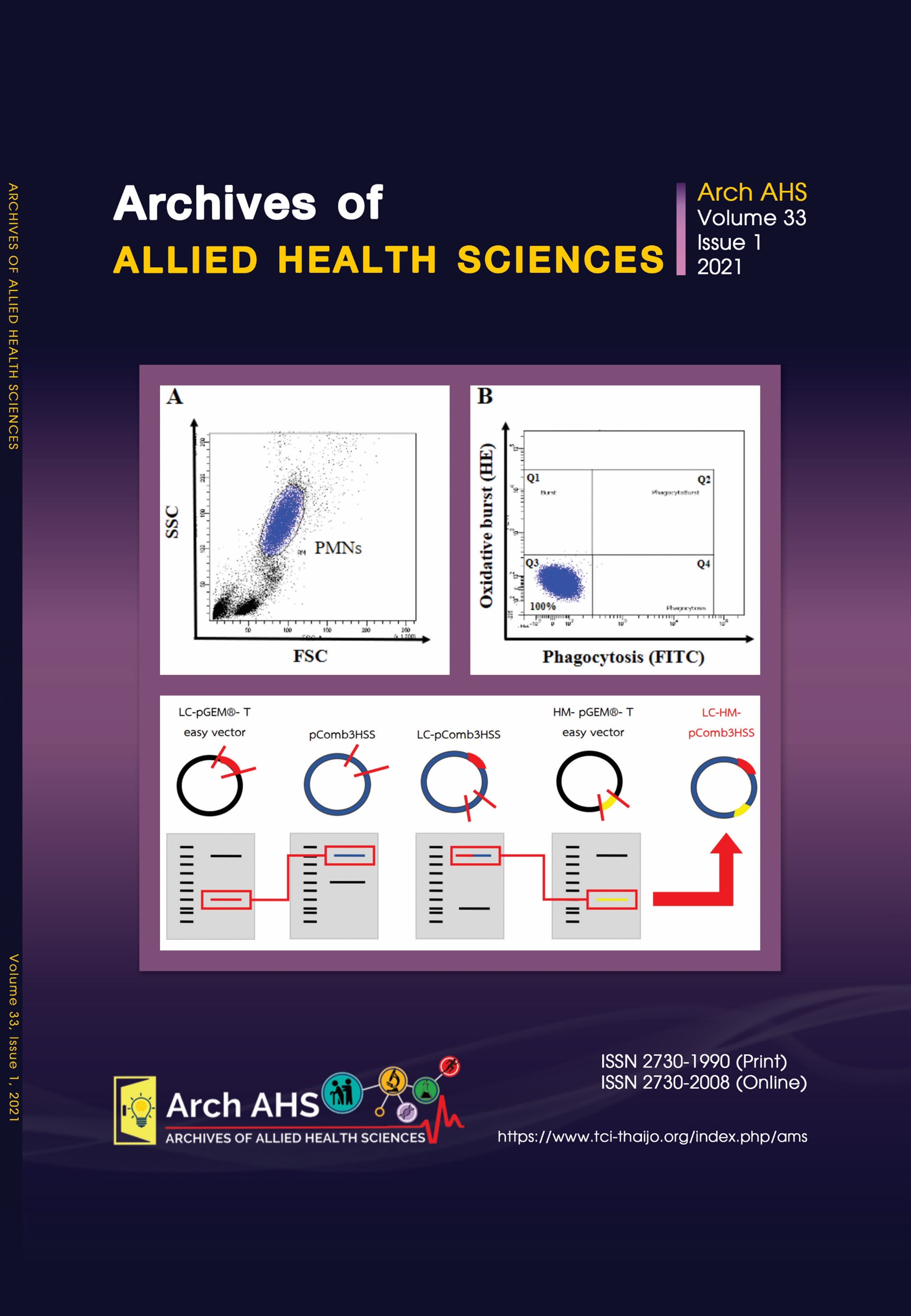Design and optimization of primer for the cloning of the mouse Fd immunoglobulin M for antibody phage display technology
Main Article Content
Abstract
Hybridoma technique is worldwide used for antibody production. However, there are many issues of using this technique such as hybridoma instability, chromosome loss, mutation and short haft-life that lead to loss
of hybridoma genome and loss of antibody production. The technique which displays antibody on phage particle can solve this problem. Therefore, antibody phage display was used to sustain the hybridoma technique to produce antibodies. In this technique, it is needed to amplify antibody sequence by a primer that is specifc to antibody isotype and have cloning site to clone antibody sequence into a phagemid vector. Unfortunately, there was no reverse primer for amplifying mouse Fd immunoglobulin M (IgM) and clone into the pComb3HSS phagemid vector. The aim of this study was to design the new reverse primers to amplify mouse Fd immunoglobulin M antibody gene by polymerase chain reaction (PCR) using KKU505 hybridoma as a model. The KKU505 hybridoma can produce anti-Opisthorchis viverrini (O. viverrini) monoclonal antibody (mAb). The results demonstrated that this new primer could amplify the Fd immunoglobulin M of anti-Opisthorchis viverrini mAb and construct into pComb3HSS phagemid vector. This technology could preserve antibody gene and use for more stable antibody production.
Article Details

This work is licensed under a Creative Commons Attribution-NonCommercial-NoDerivatives 4.0 International License.
References
Hammers CM, Stanley JR. Antibody phage display: technique and applications. J Invest Dermatol 2014; 134(2): 1-5.
Azzazy HM, Highsmith WE, Jr. Phage display technology: clinical applications and recent innovations. Clin Biochem 2002; 35(6): 425-45.
Finlay WJ, Bloom L, Grant J, Franklin E, Shuilleabhain DN, Cunningham O. Phage display: a powerful technology for the generation of high-specificity affinity reagents from alternative immune sources. Methods Mol Biol 2017; 1485: 85-99.
Saeed AF, Wang R, Ling S, Wang S. Antibody engineering for pursuing a healthier future. Front Microbiol 2017; 8: 495.
Marvin DA. Filamentous phage structure, infection and assembly. Curr Opin Struct Biol 1998; 8(2): 150-8.
Frei JC, Lai JR. Protein and antibody engineering by phage display. Methods Enzymol 2016; 580: 45-87.
Carmen S, Jermutus L. Concepts in antibody phage display. Brief Funct Genomic Proteomic 2002; 1(2): 189-203.
Nguyen HH, Park J, Park SJ, Lee CS, Hwang S, Shin YB, et al. Long-term stability and integrity of plasmid-based DNA data storage. Polymers (Basel) 2018; 10(1): 1-10.
Gravier R, Dory D, Laurentie M, Bougeard S, Cariolet R, Jestin A. In vivo tissue distribution and kinetics of a pseudorabies virus plasmid DNA vaccine after intramuscular injection in swine. Vaccine 2007; 25(39-40): 6930-8.
Barbas CF, 3rd. Recent advances in phage display. Curr Opin Biotechnol 1993; 4(5): 526-30.
Barbas CF. Synthetic human antibodies. Nat Med 1995; 1(8): 837-9.
Wang Z, Raifu M, Howard M, Smith L, Hansen D, Goldsby R, et al. Universal PCR amplification of mouse immunoglobulin gene variable regions: the design of degenerate primers and an assessment of the effect of DNA polymerase 3’ to 5’ exonuclease activity. J Immunol Methods 2000; 233(1-2): 167-77.
Chuang LY, Cheng YH, Yang CH. Specific primer design for the polymerase chain reaction. Biotechnol Lett 2013; 35(10): 1541-9.
Worasith C, Kamamia C, Yakovleva A, Duenngai K, Wangboon C, Sithithaworn J, et al. Advances in the diagnosis of human opisthorchiasis: development of opisthorchis viverrini antigen detection in urine. PLoS Negl Trop Dis 2015; 9(10): e0004157.
Hnasko RM, Stanker LH. Hybridoma technology. Methods Mol Biol 2015; 1318: 15-28.
Tomita M , Tsumoto K . Hybridoma technologies for antibody production. Immunotherapy 2011; 3(3): 371-80.
Tan Y, Tian T, Liu W, Zhu Z, C JY. Advance in phage display technology for bioanalysis. Biotechnol J 2016; 11(6): 732-45.
Phumyen A, Jumnainsong A, Leelayuwat C. Improved binding activity of antibodies against major histocompatibility complex class I chain-related gene A by phage display technology for cancer-targeted therapy. J Biomed Biotechnol 2012; 2012: 597647.
Thompson J, Pope T, Tung JS, Chan C, Hollis G, Mark G, et al. Affinity maturation of a high affinity human monoclonal antibody against the third hypervariable loop of human immunodefciency virus: use of phage display to improve affinity and broaden strain reactivity. J Mol Biol 1996; 256(1): 77-88.


